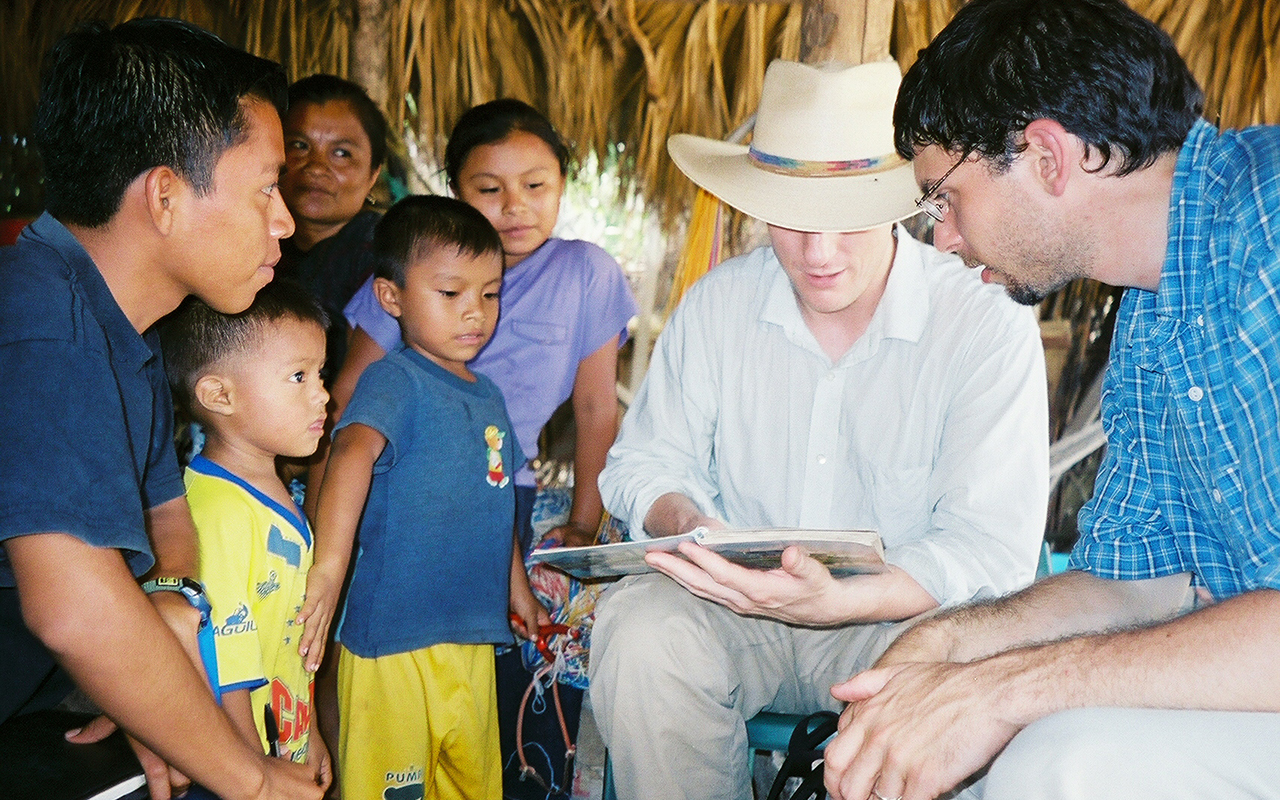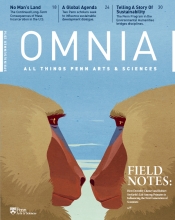Found in Translation: Linguists try to preserve spoken indigenous languages by writing them down

To get to the tiny Mexican village of Santa Maria del Mar in Oaxaca—population 800 or 1,500, depending on whom you ask—requires a 45-minute boat ride through always-choppy waters huddled under a tarp in near darkness with two dozen companions. A decade-long territorial dispute with a neighboring village has closed off other entry points.
But to Rolf Noyer, an associate professor of linguistics, making the uncomfortable journey is worth the prize at its end: The chance to work with community members on a written version of their spoken language, Huave. It’s one of a few places in the world left with speakers of this isolate, meaning it has no known relatives. “I was the first academic linguist to work on that language in 100 years,” he says.
The result of two six-week stays was an online dictionary comparing four Huave dialects and a printed volume containing extensive vocabulary and basic spelling and grammar rules for one of the languages, copies of which are now in Santa Maria del Mar. This tale of a linguist teaming up with native speakers to document a threatened tongue is part of a larger story, one about collaborations between academics and indigenous peoples to save endangered languages from extinction.
The Need for Protection
Part of this effort stems from a push by Mexico’s National Institute of Indigenous Languages (INALI). “The organization has been involved in trying to arrange practical orthographies for indigenous unwritten languages,” Noyer says.
This past March, INALI put out a notice saying that all indigenous speakers have the right to use their languages in private and public life. It’s a step toward broader acceptance of native languages, but some of these communities, aided by linguists like Noyer and Brook Lillehaugen of Haverford College, say they also want to figure out a way to write down their spoken words./p>
“A lot of people think languages aren’t valued or respected until they’re written down, which isn’t really true,” Noyer says. “There is a strong sense in a lot of the indigenous language communities that because their language is not written, it’s less important.”
These groups have been discriminated against for conversing in one of the only ways some of them know, adds Lillehaugen. “Language use is really tied into identity,” she says. “Indigenous Oaxaca is one of the most diverse linguistic areas in the world.”
Lillehaugen works there on languages in the Zapotec family, which most speakers currently do not write. However, these have a long-standing written record using the Roman alphabet, with the oldest works dating back to 1565, of which many modern native speakers aren’t aware—something Lillehaugen aims to change. She’s working with Laurie Allen, Penn Libraries’ Assistant Director for Digital Scholarship, to track down, transcribe, digitize, and analyze as many Zapotec texts as they can find. They have so far entered into their database 50 manuscripts and a 300-page book, and just received permission from the National Archives to post 50 more.
“Many academics who view themselves as allies with indigenous groups are asked by the communities to help them develop a way to write their language,” Lillehaugen says. “One reason is really for prestige of the language. There are other reasons: You might want to write to be able to communicate, to keep track of things, to have a written record.”
It also emboldens language users. In April, Allen and Lillehaugen traveled to Oaxaca to give a workshop to Zapotec speakers. “It was amazing for me to see them work through their language,” Allen says, “work through it in the writing of 18th century [texts] and wills.”
A Language Democracy
For the Huave speakers in Santa Maria del Mar, the path to a standard orthography wasn’t quite so smooth. This small village is one of four in close proximity; they all speak a version of Huave, but not the same one, and each feels pride in its variation.
In addition to Santa Maria del Mar, there’s San Mateo del Mar, the largest of the quartet and the one at odds with Santa Maria, plus San Francisco del Mar and San Dionisio del Mar. They’re all located on the Pacific Ocean, and enclose a bay called Laguna Superior. Noyer has worked in all four places.
The linguist studied Huave in graduate school but had never been to the places where it was spoken. In fact, he penned several papers about the language before he ever heard its sound. In 2004, he joined a group from the University of California, Berkeley, visiting the villages, then went back in 2006 with a cohort of Penn graduate students. When he returned to Philadelphia, the dialects fresh in his mind, Noyer created the online Comparative and Etymological Dictionary of the Huave Languages, which he hoped would provide a reference for researchers, a resource for Huave speakers, and a start to the documentation process.
“I began to develop this reputation as being someone who knew the most about [these languages],” Noyer says. INALI invited him to participate in a set of workshops aimed at bringing together linguists from around the world and schoolteachers from these Oaxacan villages—what Noyer describes as the area intelligentsia—to write down the languages.
These are equivalent to elementary schoolteachers, people tasked with educating the village children. “The linguists, we came with an artificial understanding of these languages. We don’t speak them natively, but we understand language structure,” he says. “The workshops involved this interplay between the community and people from the outside.”
Unexpected Challenges
Unforeseen disputes arose, like one Noyer didn’t expect over spelling. Most historical attempts to write down Huave came from Spanish-speaking priests or missionaries who tried to keep spelling consistent with the language they knew. This had a backlash effect, in some cases prompting modern native speakers to move as far away from Spanish as possible in how they wrote their words.
For instance, one group decided that any word with the lettering “ti” or “te” in it should instead be spelled “tyi” or “tye” in an effort to precisely reflect the sound of the letter t in Huave rather than its Spanish pronunciation. Linguistically, however, this was impractical because t, when placed before an i or an e in Huave, already has the sound these speakers sought.
Another challenge arose over use of the letters k, c, and q. Most linguists prefer the k for that hard sound because it’s simpler and less ambiguous, but some older speakers—having learned the c and q spellings when they learned Spanish—held this lettering to be more proper. “The younger speakers, in line with a general trend among indigenous language speakers in Mexico and Guatemala, have taken up the use of k as a way of distancing themselves from Spanish,” Noyer says. “This letter alone has come to symbolize a kind of indigenous pride."
Each group’s specific dialect is another source of pride. One community might want to vary how it writes a word simply to symbolize its individuality. The four Oaxacan villages even have different names for their languages, which none actually calls Huave. San Dionisio and San Francisco call it umbeyajts. For San Mateo, it is ombeayiiüts and for Santa Maria, it is umbeyüjts. Each is some variation of the phrase “our mouth.”
Often, Noyer says, these clashes take on social or political significance. “I was trained as a linguist; I understand this intellectually. But I am not an anthropologist and I am not a politician,” he says. “It’s really interesting to observe this dynamic and to work within it, to find something that is satisfactory to everyone and is linguistically sensible.” Sometimes, like when he worked in San Dionisio del Mar, it came down to an actual raise-your-hand vote.
The Future of this Work
Ultimately, the future of these languages lies with the next generation.
To that end, Lillehaugen is working on another Zapotec project that supported half a dozen teenagers who speak the language to write in it by tweeting at least five times a week for seven weeks. Her students at Haverford promised to “read” the tweets (though they themselves don’t speak the language) and engage in conversation with the Mexican high schoolers. Lillehaugen left it up to the Zapotec speakers to determine spelling.
“Rolf is working on creating a standard orthography. We took a slightly different route,” she says. “We basically said, ‘Write any way you want to.’ There is no codified way.”
Each tweet contains the hash tag #usatuvoz, which means, “Use your voice.” “If you look for #usatuvoz, you’ll find hundreds of tweets in Zapotec,” Lillehaugen adds. “It’s a way to encourage people to write in a very unusual situation.” According to the researcher, the project invigorated the high schoolers, who continue tweeting in Zapotec even though their commitment has concluded.
Noyer says in San Mateo del Mar, with its population of around 13,000, children learn both Huave and Spanish at school and at home, but in the other three villages, finding Huave speakers—let alone those interested in documenting the language—poses a challenge. In at least one of them, Noyer guesses the youngest natives who know Huave are in their 40s; in another, the youngest have already reached age 70.
“One thing that’s really important in preserving languages is to get children to learn them,” he says. In the United States, one model pairs elderly with preschoolers, tasking the older generation to educate the newest on what they know. “Ultimately, this is something they would like to do in Mexico, have older people in the community … teaching [children] the language,” he adds. Noyer is currently working on children’s picture books full of local animals and plants that grandparents can read to their grandchildren.
It will take at least such efforts, aided by the support of advocates like Noyer, Lillehaugen, and Allen, to preserve these native tongues. “These are endangered languages,” Allen says. “They’re losing more speakers than they’re gaining all the time.” With INALI backing the push to preserve them, this battle is one linguists know is worth fighting.





